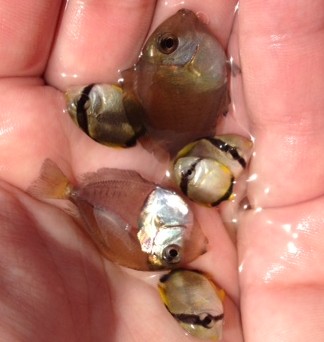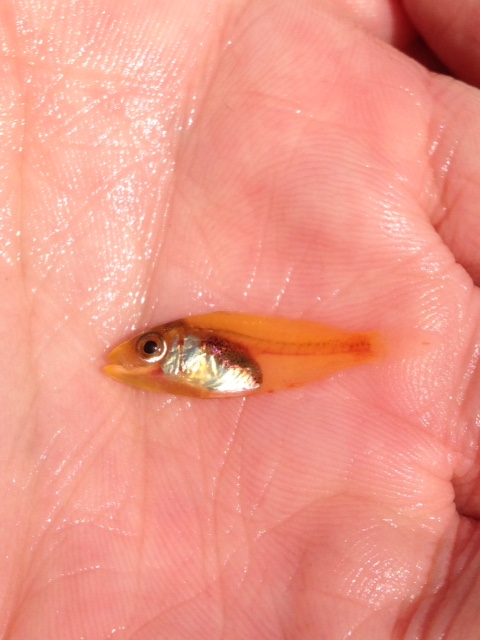 Last week I reported on the arrival of the first tropical fishes of the year to appear in Long Island waters after a seining trip at Fire Island inlet turned up a filefish, groupers, and northern sennets. This week I am happy to announce that the next wave has arrived. Yesterday I accompanied a group of aquarists from the Long Island Aquarium on their first collecting trip of the season, on the north side of Shinnecock Bay. In addition to most of the same species from last week’s trip, we also encountered, ahead of schedule, what appears to be the next wave of tropicals: at least 20 spotfin butterflyfish and two post-larval tangs. The tangs are probably doctorfish (Acanthurus chirurgus), but it’s too early to say. The catch also included silversides, northern pipefish, two species of flounder, hundreds of tiny sea robins, seaboard gobies, baby bluefish, and our two native temperate wrasses, the cunner and tautog.
Last week I reported on the arrival of the first tropical fishes of the year to appear in Long Island waters after a seining trip at Fire Island inlet turned up a filefish, groupers, and northern sennets. This week I am happy to announce that the next wave has arrived. Yesterday I accompanied a group of aquarists from the Long Island Aquarium on their first collecting trip of the season, on the north side of Shinnecock Bay. In addition to most of the same species from last week’s trip, we also encountered, ahead of schedule, what appears to be the next wave of tropicals: at least 20 spotfin butterflyfish and two post-larval tangs. The tangs are probably doctorfish (Acanthurus chirurgus), but it’s too early to say. The catch also included silversides, northern pipefish, two species of flounder, hundreds of tiny sea robins, seaboard gobies, baby bluefish, and our two native temperate wrasses, the cunner and tautog.
The water was thick with lion’s mane jellies, one of the worst stingers around, so one intern was appointed to jelly duty, responsible for scooping jellies out of the path of the seine using a dip net. A large jelly in the net can do considerable damage to your catch. They can also give you a nasty sting, which is why I always keep a bottle of white vinegar in my car this time of year. The acid in the vinegar denatures the proteins in the Jelly’s venom and provides instant relief from the sting (yes, even better than having someone pee on you).
Inspired by our catch, I proceeded to Shinnecock Inlet after seining to see what else might turn up. I was thrilled to see multiple leatherback turtles in and around the inlet, a sure sign of tropical water. Hopefully they were feeding on some of those jellies. Altough I had a lot of work to do back at my lab, I couldn’t resist putting on my dive gear and jumping in the water. I didn’t get close to any leatherbacks, and the incoming ocean water was much colder than our seining site, but I did get a look at some cool local marine life. Check back Monday for video highlights.











0 Comments